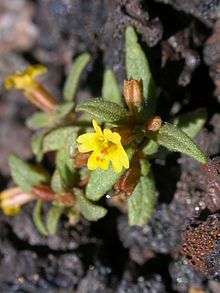Erythranthe suksdorfii
| Erythranthe suksdorfii | |
|---|---|
 | |
| Scientific classification | |
| Kingdom: | Plantae |
| (unranked): | Angiosperms |
| (unranked): | Eudicots |
| (unranked): | Asterids |
| Order: | Lamiales |
| Family: | Phrymaceae |
| Genus: | Erythranthe |
| Species: | E. suksdorfii |
| Binomial name | |
| Erythranthe suksdorfii (A. Gray) N.S.Fraga | |
Erythranthe suksdorfii, with the common names Suksdorf's monkeyflower and miniature monkeyflower, is an annual flowering plant in the family Phrymaceae (Lopseed). It was formerly known as Mimulus suksdorfii.[1][2][3][4] A specimen collected in Washington state in 1885 by the self-taught immigrant botanist Wilhelm Nikolaus Suksdorf was identified as a new species by Asa Gray in 1886, who named it in Suksdorf's honor.[5][6] It can easily be misidentified with Erythranthe breviflora, which generally has elliptic leaves rather than the linear or oblong leaves found in E. suksdorfii.[7]
Distribution
E. suksdorfii is native to Washington, Oregon, California, Idaho, Montana, Wyoming, Colorado, Nevada, Utah, Arizona, and New Mexico.[5] The plant prefers valleys and foothills in mountainous areas at elevations of 130–2,160 meters (430–7,090 ft).[7] It grows well in wetland-riparian areas that are moist in springtime and forests with Yellow Pine, Red Fir, and/or Lodgepole Pine in subalpine regions.[8] Soils with good drainage are preferred.[9] Its range has been severely impacted by human activity,[7][10] resulting in having the status of "sensitive" from the Bureau of Land Management and United States Forest Service.[7]
Description
E. suksdorfii is a dicot herb.[8] The petals are yellow and have red spots that appear from the throat to the lower corolla lobe, which is only 4–6.5 millimeters (0.16–0.26 in) long.[5] It flowers from mid-April to July, depending upon locality.[11] The calyx is mildly hairy. The leaves are opposite, slender, tapered, and hairy and generally sessile. The plant grows to a height of 3–10 centimeters (1.2–3.9 in).[7]
References
- ↑ Barker, W. L. (Bill); et al. (2012). "A Taxonomic Conspectus of Phyrmaceae: A Narrowed Circumscription for MIMULUS, New and Resurrected Genera, and New Names and Combinations" (PDF). Phytoneuron. 39: 1–60. ISSN 2153-733X.
- ↑ Beardsley, P. M.; Yen, Alan; Olmstead, R. G. (2003). "AFLP Phylogeny of Mimulus Section Erythranthe and the Evolution of Hummingbird Pollination". Evolution. 57 (6): 1397–1410. JSTOR 3448862.
- ↑ Beardsley, P. M.; Olmstead, R. G. (2002). "Redefining Phrymaceae: the placement of Mimulus, tribe Mimuleae, and Phryma". American Journal of Botany. 89 (7): 1093–1102. JSTOR 4122195. doi:10.3732/ajb.89.7.1093.
- ↑ Beardsley, P. M.; Schoenig, Steve E.; Whittall, Justen B.; Olmstead, Richard G. (2004). "Patterns of Evolution in Western North American Mimulus (Phrymaceae)". American Journal of Botany. 91 (3): 474–4890. JSTOR 4123743.
- 1 2 3 "Mimulus suksdorfii (Suksdorf's Monkeyflower)". Southwest Colorado Wildflowers. Retrieved 11 February 2017.
- ↑ Love, Rhoda M. (Fall 1998). "Wilhelm Nikolaus Suksdorf (1850–1932) Pioneer Botanist of the Pacific Northwest" (PDF). Pacific Northwest Quarterly: 1.
- 1 2 3 4 5 "Erythranthe suksdorfii (A. Gray) N. S. Fraga" (PDF). Washington Department of Natural Resources. Retrieved 11 February 2017.
- 1 2 "Mimulus suksdorfii (A. Gray)". Calflora. Retrieved 11 February 2017.
- ↑ Rundel,, Philip W.; Gibson, Arthur C.; Sharifi, M. Rasoul (2008). "The Alpine Flora of the White Mountains, California". Madroño. 55 (3): 202–215. JSTOR 41431655.
- ↑ "Erythranthe suksdorfii (A. Gray) N. S. Fraga". SEInet. Retrieved 11 February 2017.
- ↑ "Erythranthe suksdorfii". Bruke Museum of Natural History and Culture, University of Washington. Retrieved 11 February 2017.
External links
-
 Media related to Erythranthe suksdorfii at Wikimedia Commons
Media related to Erythranthe suksdorfii at Wikimedia Commons -
 Data related to Erythranthe suksdorfii at Wikispecies
Data related to Erythranthe suksdorfii at Wikispecies